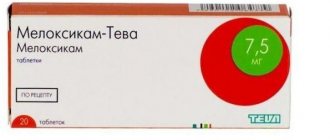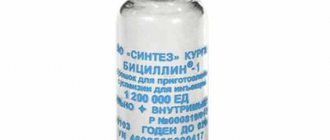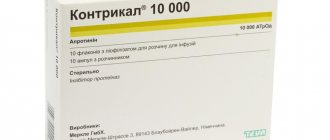Indications for use of the drug ALPHA D3-TEVA®
- osteoporosis (including postmenopausal, senile, steroid);
- osteodystrophy in chronic renal failure;
- hypoparathyroidism and pseudohypoparathyroidism;
- hyperparathyroidism (with bone damage);
- rickets and osteomalacia associated with malnutrition or malabsorption;
- hypophosphatemic vitamin D-resistant rickets and osteomalacia;
- pseudodeficiency (vitamin D-dependent) rickets and osteomalacia;
- Fanconi syndrome (hereditary renal acidosis with nephrocalcinosis, late rickets and adiposogenital dystrophy);
- renal acidosis.
pharmachologic effect
Vitamin is a regulator of calcium-phosphorus metabolism.
It is a precursor to the active metabolite of vitamin D3. Increases the absorption of calcium and phosphorus in the intestines, increases their reabsorption in the kidneys, enhances bone mineralization, and reduces the level of parathyroid hormone in the blood. Alpha D3-Teva® restores a positive calcium balance in the treatment of calcium malabsorption, thereby reducing the intensity of bone resorption, which helps reduce the incidence of fractures.
In elderly patients against the background of endocrine-immune dysfunction, incl. deficiency of D-hormone production (a pharmacologically active metabolite of vitamin D), there is a decrease in total muscle mass (sarcopenia) and the appearance of muscle weakness syndrome (due to disruption of the normal functioning of the neuromuscular system), which is accompanied by an increased risk of falls and resulting injuries and fractures. A number of studies have shown a significant reduction in the incidence of falls in elderly patients when using alfacalcidol.
Pharmacological properties
Pharmacodynamics
1α-hydroxyvitamin D3 (alfacalcidol) is rapidly converted in the liver into 1,25-dihydroxyvitamin D3, which is an active metabolite of vitamin D (calcitriol) and acts as a regulator of phosphorus and calcium metabolism. Increases the absorption of phosphorus and calcium in the intestines, increases the reabsorption of these elements in the kidneys, when treating calcium malabsorption syndrome, ensures the restoration of a positive calcium balance, and reduces the concentration of parathyroid hormone in the blood.
Alfacalcidol affects resorption and synthesis in the process of bone remodeling, increases the mineralization of bone tissue, increases its elasticity by stimulating the synthesis of bone morphogenetic proteins, bone matrix proteins, bone growth factors (the incidence of fractures decreases).
In elderly patients, against the background of developing endocrine-immune dysfunction (including deficiency of D-hormone production), total muscle mass decreases, and muscle weakness syndrome appears due to disruption of the normal function of the neuromuscular system. The described phenomena are accompanied by an increased likelihood of falls and, as a consequence, an increased risk of fractures and injuries. A number of studies with the use of alfacalcidol have documented a significant reduction in the incidence of falls in elderly patients. Alfacalcidol promotes the regeneration of muscle fibers and restores muscle tone.
Pharmacokinetics
After oral administration, alfacalcidol is rapidly absorbed from the gastrointestinal tract. The time to reach maximum plasma concentration after a single dose is 8–12 hours.
Alfacalcidol is metabolized to calcitriol (1,25-dihydroxycolecalciferol) in the liver. The main route is hydroxylation at the 25th carbon atom. The hydroxylation process proceeds very quickly (it differs in its substrate-dependent nature). Alfacalcidol, unlike native vitamin D, does not require hydroxylation in the kidneys, so it is effective even in those patients who have reduced renal 1-alpha-hydroxylase activity (with kidney disease or in old age).
It is excreted in approximately equal parts by the kidneys and with bile through the intestines. The half-life is 19 days.
Dosage regimen
The drug is taken orally. The duration of the course is determined by the doctor individually and depends on the nature of the disease and the effectiveness of therapy.
For adults
for
rickets and osteomalacia
caused by exogenous vitamin D deficiency, gastrointestinal diseases or long-term anticonvulsant therapy, the drug is prescribed at a dose of 1-3 mcg/day.
- For hypoparathyroidism
, the daily dose is 2-4 mcg. - For osteodystrophy in chronic renal failure,
the daily dose is up to 2 mcg. - For Fanconi syndrome and renal acidosis,
the drug is prescribed in a daily dose of 2-6 mcg. - For hypophosphatemic rickets and osteomalacia,
the daily dose is 4-20 mcg. - For postmenopausal, senile, steroid and other types of osteoporosis,
the daily dose is 0.5-1 mcg.
It is recommended to start treatment with the minimum indicated doses, monitoring the level of calcium and phosphorus in the blood plasma once a week. The dose of the drug can be increased by 0.25-0.5 mcg/day. until biochemical parameters stabilize. Once the minimum effective dose is reached, it is recommended to monitor plasma calcium levels every 3-5 weeks.
Reviews
Marina, 36 years old “The birth of a second child in our family brought great joy. However, how much we went through for him to become healthy and full-fledged, like other children. As I grew, I noticed that my peers were much larger than my son. When he began to move independently, any fall caused a dislocation and even a fracture. Diagnostics showed that he had a metabolic disorder, which caused rickets. It is this that prevents bones from becoming strong and durable. The doctor prescribed us Alpha D3-Teva, which we took for several months. After treatment, the child began to grow quickly, his bones became strong and full-fledged.”
Veronica, 31 years old “My mother was recently diagnosed with osteoporosis. This is a dangerous disease that requires immediate treatment, but my mother ignored it for a long time. Problems came when she broke her leg one winter day. The fracture did not heal for several months. To speed up the recovery process, the doctor prescribed Alpha d3-Teva. She took the pills for quite a long time and continued to take them even after her leg healed. But now her bones are much stronger than they were before.”
Victor, 63 years old “Several years ago I noticed that my hump began to grow. For a long time I didn’t attach any importance to this, but my wife finally forced me to go to the doctor. Detailed diagnostics showed that I have osteomalacia. This means. That the volume of bone tissue increases, but they do not become bones. To get rid of this disease, I was prescribed Alpha D3-Teva. I took the drug for a very long time, about six months. But during this period I was able to normalize metabolic processes, which helped get rid of the hump. In general, the therapy left extremely positive emotions.”
Side effect
From the side of metabolism:
rarely - hypercalcemia; very rarely - a slight increase in HDL in the blood plasma. In patients with severe renal impairment, hyperphosphatemia may develop.
From the digestive system:
anorexia, vomiting, heartburn, abdominal pain, nausea, dry mouth, discomfort in the epigastric region, constipation, diarrhea; rarely - a slight increase in ALT, AST in plasma.
From the side of the central nervous system:
rarely - weakness, fatigue, headache, dizziness, drowsiness.
From the cardiovascular system:
rarely - tachycardia.
From the musculoskeletal system:
moderate pain in muscles, bones, joints.
Allergic reactions:
rarely - skin rash, itching.
Contraindications to the use of the drug ALPHA D3-TEVA®
- hypercalcemia;
- hyperphosphatemia (except for hyperphosphatemia in hyperparathyroidism);
- hypermagnesemia;
- hypervitaminosis D;
- lactation period;
- hypersensitivity to the components of the drug.
Carefully _
the drug should be prescribed for nephrolithiasis, atherosclerosis, heart failure, renal failure, sarcoidosis, pulmonary tuberculosis (active form), patients with an increased risk of developing hypercalcemia, especially in the presence of urolithiasis.
Pharmacokinetics
Alpha D3-teva is available in tablet form. Immediately after their use, they break down into active substances, due to which alfacalcidol, the active substance of the drug, can be rapidly absorbed by the gastrointestinal tract.
It has been proven that the maximum concentration of drugs in the body occurs 10-12 hours after administration. The active components are processed by the liver - they break down into many substances that are easily excreted by the body. The half-life is 19 days, most of the components are excreted through the intestines.
special instructions
During the period of use of the drug, it is necessary to regularly (at least once every 3 months) determine the level of calcium in the blood plasma and urine, monitor the development of the therapeutic effect and, if necessary, adjust the dose of the drug to avoid the development of hypercalcemia and hypercalciuria.
If there are biochemical signs of normalization of bone structure (normalization of alkaline phosphatase content in the blood plasma), an appropriate reduction in the dose of Alpha D3-Teva® is necessary, which avoids the development of hypercalcemia.
Hypercalcemia or hypercalciuria can be corrected by discontinuing the drug and reducing calcium intake until plasma calcium concentrations normalize. Typically this period is 1 week. Therapy can then be continued, starting with half the last dose used.
Alpha D3-teva
Use during pregnancy and breastfeeding
The drug is contraindicated for use during pregnancy and breastfeeding.
Hypercalcemia in the mother during pregnancy, associated with prolonged overdose of vitamin D, can cause increased sensitivity to vitamin D in the fetus, suppression of parathyroid function, specific elf-like appearance syndrome, mental retardation, and aortic stenosis.
Use for renal impairment
The drug should be prescribed with caution in case of renal failure.
Use in children
Contraindicated in children under 3 years of age.
special instructions
When using the drug Alpha D3-Teva® in children and in patients with chronic renal failure, it is necessary to regularly monitor the calcium and phosphate levels (at the beginning of treatment - once a week, when Cmax is reached in the blood plasma and during the entire treatment period - every 3 -5 weeks), as well as alkaline phosphatase activity (for chronic renal failure - weekly monitoring) in the blood plasma. In chronic renal failure, preliminary correction of hyperphosphatemia is required.
When normal ALP activity in the blood plasma is achieved, the dose of Alpha D3-Teva® must be reduced, which will avoid the development of hypercalcemia.
At the beginning of treatment with Alpha D3-Teva®, it is recommended to measure calcium levels, especially in conditions without significant bone damage, for example, with hypoparathyroidism and in cases where plasma calcium levels are already elevated, and also at later stages of treatment - if there are signs of recovery bone tissue structure.
The risk of developing hypercalcemia is determined by factors such as the degree of bone demineralization, renal function, and drug dose.
Hypercalcemia or hypercalciuria is corrected by reducing the dose of Alpha D3-Teva® and reducing calcium intake until its content in the blood plasma is normalized. Typically this period is 1 week. After normalization, therapy is continued using half of the last dose used.
If hypercalcemia develops or a persistent increase in the content of calcium phosphate compounds beyond the clinical norm, the drug should be immediately discontinued, at least until these indicators return to normal (usually within a week), then use of the drug can be resumed at a dose , which is half the previous one.
Patients with severe bone damage (as opposed to patients with renal failure) can tolerate higher doses of the drug without signs of hypercalcemia. The absence of a rapid increase in calcium levels in the blood plasma in patients with osteomalacia does not always mean that the dose of the drug should be increased, because calcium can penetrate into demineralized bone due to its increased absorption in the intestine.
The development of long-term hypercalcemia should be prevented, especially in chronic renal failure, focusing on indicators such as calcium content in blood serum and urine, alkaline phosphatase activity, parathyroid hormone concentration, radiological and histological data.
To prevent the development of hyperphosphatemia in patients with bone lesions of renal origin, alfacalcidol can be used together with phosphate binders.
It must be taken into account that sensitivity to vitamin D varies from patient to patient, and sometimes the use of even therapeutic doses may be accompanied by symptoms of hypervitaminosis.
Children who receive vitamin D for a long time are at increased risk of stunted growth.
To prevent hypovitaminosis D, a balanced diet is most preferable. In old age, the need for vitamin D may increase due to a decrease in the absorption of vitamin D, a decrease in the skin's ability to synthesize provitamin D3, a decrease in sun exposure, and an increase in the incidence of renal failure.
The excipients of the drug include peanut oil. The drug is contraindicated in patients with an allergic reaction to peanut oil and soybean oil.
Impact on the ability to drive vehicles and operate machinery
Caution should be exercised when driving vehicles and mechanisms that require increased concentration and speed of psychomotor reactions, since dizziness and drowsiness may develop when using the drug Alpha D3-Teva®.
Overdose
Early symptoms of hypervitaminosis D (due to hypercalcemia):
diarrhea, constipation, nausea, vomiting, dry mouth, anorexia, metallic taste in the mouth, hypercalciuria, polyuria, polydipsia, pollakiuria/nocturia, headache, fatigue, general weakness, myalgia, bone pain.
Late symptoms of hypervitaminosis D:
dizziness, confusion, drowsiness, cloudy urine, cardiac arrhythmia, skin itching, increased blood pressure, conjunctival hyperemia, nephrolithiasis, weight loss, photophobia, pancreatitis, gastralgia; rarely - changes in psyche and mood.
Symptoms of chronic vitamin D intoxication:
calcification of soft tissues, blood vessels and internal organs (kidneys, lungs), renal and cardiovascular failure up to death, growth disturbance in children.
Treatment:
the drug should be discontinued. In the early stages of acute overdose, gastric lavage and/or administration of mineral oil may have a positive effect (which helps reduce absorption and increase excretion of the drug in feces). In severe cases, it may be necessary to carry out supportive treatment measures - hydration with the introduction of infusion saline solutions, in some cases - the appointment of “loop” diuretics, corticosteroids, bisphosphonates, calcitonin, and hemodialysis using solutions with low calcium content. It is recommended to monitor blood electrolytes, renal function and cardiac status (as measured by ECG), especially in patients receiving digoxin.
Drug interactions
In the treatment of osteoporosis, Alpha D3-Teva® can be prescribed in combination with estrogens and antiresorptive drugs of different groups.
When using Alpha D3-Teva® simultaneously with digitalis preparations, the risk of developing heart rhythm disturbances increases.
When prescribed simultaneously with barbiturates, anticonvulsants and other drugs that activate microsomal oxidation enzymes in the liver, it is necessary to use Alpha D3-Teva® in higher doses.
The absorption of alfacalcidol is reduced when it is used together with mineral oil (for a long time), cholestyramine, colestipol, sucralfate, antacids, and albumin-based drugs.
When used simultaneously with Alpha D3-Teva® antacids, the risk of developing hypermagnesemia increases.
The simultaneous administration of calcium supplements and thiazide diuretics increases the risk of developing hypercalcemia.
During Alpha D3-Teva® therapy, vitamin D and its derivatives should not be prescribed due to possible additive interactions and an increased risk of hypercalcemia.
Use during pregnancy and lactation
During pregnancy, if the mother has hypercalcemia caused by a long-term overdose of vitamin D, the fetus may develop increased sensitivity to vitamin D with suppression of parathyroid function, the occurrence of a specific elf-like appearance syndrome, mental retardation and aortic stenosis.
During pregnancy, the use of Alpha D3-Teva is allowed only under strict indications, if the expected risk to the fetus is lower than the potential benefit to the mother.
It is forbidden to use Alpha D3-Teva during breastfeeding.








